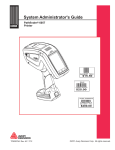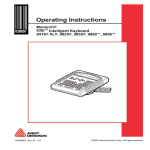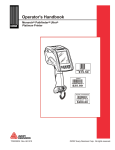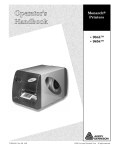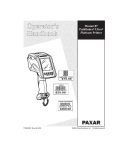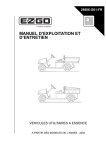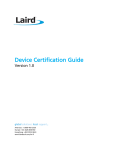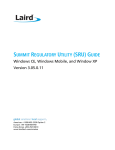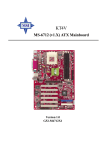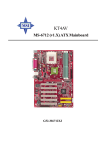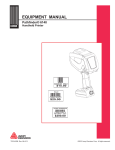Download System Administrator`s Guide
Transcript
System Administrator's Guide 0 28028 Monarch® Pathfinder ® Ultra® Platinum Printer 653258 04/18/07 7512 $15.50 SALE 4 58523 32232 9 $25.00 PEARL EARRINGS 8 99565 45453 9 04/18/07 7512 $200.00 TC6039SA Rev. AH 11/09 ©2007 Avery Dennison Corp. All rights reserved. Each product and program carries a respective written warranty, the only warranty on which the customer can rely. Avery Dennison reserves the right to make changes in the product, the programs, and their availability at any time and without notice. Although Avery Dennison has made every effort to provide complete and accurate information in this manual, Avery Dennison shall not be liable for any omissions or inaccuracies. Any update will be incorporated in a later edition of this manual. 2006 Avery Dennison Corporation. All rights reserved. No part of this publication may be reproduced, transmitted, stored in a retrieval system, or translated into any language in any form by any means, without the prior written permission of Avery Dennison. This device has been tested and found to comply with the limits for a Class B digital device pursuant to Part 15 of the Federal Communications Commissions Rules and Regulation. These limits are designed to provide reasonable protection against harmful interference when the equipment is operated in a commercial environment. This equipment generates, uses, and can radiate radio frequency energy and, if not installed and used in accordance with the instruction manual, may cause harmful interference to radio communications. Operation of this equipment in a residential area is likely to cause harmful interference in which case the user will be required to correct the interference at his own expense. However, there is no guarantee that interference will not occur in a particular installation. If the equipment does cause harmful interference to radio or television reception, which can be determined by turning the equipment off and on, the user is encouraged to try to correct the interference by one or more of the following measures: ♦ Re-orient or relocate the receiving antenna. ♦ Increase the separation between the equipment and receiver. ♦ Connect the equipment into an outlet on a circuit different from that which the receiver is connected. This Class B digital apparatus meets the requirements of the Canadian Interference-Causing Equipment Regulations. Cet appareil numérique de la Classe B respecte toutes les exigences du Règlement sur le Matériel Brouilleur du Canada. Trademarks Monarch®, Pathfinder®, Ultra®, 6039, 6063, 9462, and 9465 are trademarks of Avery Dennison Retail Information Services, LLC. Avery Dennison® is a trademark of Avery Dennison Corporation. Microsoft and Windows are trademarks of Microsoft Corporation. Summit Data Communications is a trademark of Summit Data Communications, Inc. Avery Dennison Printer Systems Division 170 Monarch Lane Miamisburg, OH 45342 Outside the U.S., send batteries to: EMEA, 4 Awberry Court Croxley Business Park, Hatters Lane, Watford, WD18 8PD TA B L E O F C O N T E N T S INTRODUCTION ...................................................................................................................... 1-1 Using This Manual .............................................................................................................. 1-1 Audience ........................................................................................................................... 1-1 ADMINISTRATIVE TOOLS ........................................................................................................ 2-1 Using the Taskbar Lockdown Option..................................................................................... 2-1 Locking the Taskbar ........................................................................................................ 2-1 Removing Applications .................................................................................................... 2-2 Unlocking the Taskbar ..................................................................................................... 2-2 Using Asset Tracking .......................................................................................................... 2-2 Editing Owner Data ......................................................................................................... 2-2 Printing an Asset Tracking Label ...................................................................................... 2-3 Using Printer Passthru ........................................................................................................ 2-3 CONFIGURING WIRELESS SETTINGS ...................................................................................... 3-1 About the Symbol® 802.11b Wireless Card ........................................................................... 3-1 Using the Mobile Companion ............................................................................................... 3-1 Finding a Network ........................................................................................................... 3-1 Creating a Profile ............................................................................................................ 3-2 Setting a Password ......................................................................................................... 3-3 About the Motorola® 802.11b/g Wireless Card ...................................................................... 3-4 Using Fusion ..................................................................................................................... 3-4 Finding a Network ........................................................................................................... 3-4 Creating a Profile ............................................................................................................ 3-5 Setting a Password ......................................................................................................... 3-6 About the Summit 802.11g Wireless Card ............................................................................. 3-7 Using the Summit Client Utility ............................................................................................ 3-7 Finding a Network ........................................................................................................... 3-8 Creating a Profile ............................................................................................................ 3-9 About ThirdPartyConfig ................................................................................................ 3-10 Setting a Password ....................................................................................................... 3-10 USING PRINTER DIAGNOSTICS ............................................................................................... 4-1 Accessing Printer Diagnostics ............................................................................................. 4-1 Testing the Print Engine...................................................................................................... 4-2 Checking Machine Totals ................................................................................................. 4-2 Printing Diagnostic Labels ............................................................................................... 4-3 Checking the Stock Registration ....................................................................................... 4-4 Testing the Sensors ........................................................................................................ 4-5 Testing the Printhead ...................................................................................................... 4-7 Viewing the Print Engine Memory Expansion Directory ........................................................ 4-8 Testing the Keypad ......................................................................................................... 4-9 Testing the Speaker ........................................................................................................ 4-9 i CONFIGURING THE SCANNER ................................................................................................ 5-1 Setting Scanner Options ..................................................................................................... 5-1 Enabling Specific Bar Codes ............................................................................................... 5-3 Configuring UPC/EAN Bar Codes ......................................................................................... 5-4 Configuring Code 39 Bar Codes ........................................................................................... 5-5 Configuring Code 128 Bar Codes ......................................................................................... 5-6 Configuring I 2of5 Bar Codes............................................................................................... 5-6 Configuring MSI Bar Codes ................................................................................................. 5-7 Configuring MSI Bar Codes ................................................................................................. 5-7 Configuring Codabar Bar Codes ........................................................................................... 5-7 Configuring Code 93 Bar Codes ........................................................................................... 5-8 Configuring D 2of5 Bar Codes ............................................................................................. 5-8 Configuring RSS Bar Codes ................................................................................................ 5-8 Scannable Bar Codes vs. Printable Bar Codes ...................................................................... 5-9 USING SCANNER DIAGNOSTICS ............................................................................................. 6-1 Performing Scanner Diagnostics .......................................................................................... 6-1 Setting the Scanner Mode ................................................................................................... 6-2 Setting the Trigger Mode..................................................................................................... 6-2 SCAN STATUS VALUES .......................................................................................................... A-1 ii INTRODUCTION The Monarch® Pathfinder® Ultra® Platinum 6039™ printer prints, scans bar codes, collects data, and communicates with other devices. The printer operates on a modified Microsoft Windows CE platform. 1 Information in this document supercedes information in previous versions. Check our Web site for the latest documentation and release information. Note: Before you begin, review the safety information in the Regulatory Compliance document included with your printer. Using This Manual Following is a summary of the contents of this manual. Chapter Contents 1 Introduction Information you should know before using the printer. 2 Administrative Tools Using the taskbar lockdown, asset tracking, and printer passthru options. 3 Wireless Configuration Setting communications between your wireless printer and network. 4 Printer Diagnostics Using printer diagnostics to print test labels, check sensors, view inches printed, etc. 5 Scanner Configuration Configuring the scanner to accept certain bar codes and setting the scanner and trigger modes. 6 Scanner Diagnostics Using scanner diagnostics. Audience This manual is for the System Administrator who configures the printer and scanner and performs diagnostics. A Quick Reference for this printer is available in the box. The Programmer’s Manual and other documentation are available on our Web site. Introduction 1-1 1-2 System Administrator’s Guide A D M I N I S T R AT I V E T O O L S 2 Use these tools to ♦ lock the taskbar to restrict user access ♦ identify and track your printers ♦ send MPCLII packets directly to the printer. Using the Taskbar Lockdown Option The Taskbar Lockdown option prevents access to the Start Menu or any unspecified applications without a password. The system administrator selects which applications are accessible when the taskbar is locked. Locking the Taskbar 1. From the Start Menu, tap Settings, Control Panel, Taskbar Lockdown. 2. Check Enable under the Basic tab. 3. Select the Startup Mode for the user or administrator. To disable the clock display on the taskbar, uncheck the Enable Clock on User Bar. 4. Enter and confirm a password. The default password is 123321. Note: Make a note of the password if you change it. You must have the current password to unlock the taskbar. 5. Tap the Applications tab. 6. Tap the browse button (…) and select an application that the user has permission to run. 7. Tap OK. The selected application path appears in the browse field. Administrative Tools 2-1 8. Tap Add. The application appears in the list. 9. When you are finished, tap OK, then Yes. The printer restarts. A small lock icon appears over the Start Menu when the taskbar is locked. Lock Icon Removing Applications If an application is removed f rom the list, the user no longer has access to that application when the taskbar is locked. 1. From the Taskbar L ockdown screen, tap the Applications tab. 2. Select the application to remove from the list. 3. Tap Remove. The application disappears from the list. 4. When you are finished, tap OK, then Yes. The printer re starts. Unlocking the Taskbar To unlock the taskbar: 1. Tap the lock icon at the bottom-left of the taskbar. The Input Panel keyboard appears on the display. 2. Enter the Admini strator password and tap OK. To re-lock the taskbar, tap the lock icon again, whic h has moved to the bottom-right side of the screen. Using Asset Tracking Asset tracking contains the manufacturer’s product ID and serial number, and the owner’s product ID and serial number. A password is required to edit this data. You can print an as set tracking label that contains the product IDs and serial numbers for your records. Editing Owner Data 1. From the Start Menu , tap Settings, Control Panel, Asset Tracking. 2-2 System Administrator’s Guide 2. Tap Edit. Use the keypad to enter the password and press Enter. The default password is 123321. The Owner Product ID field is highlighted. 3. Use the keypad or scan a bar code to enter a new Product ID and press Enter. The Owner Serial Number field is highlighted. 4. Use the keypad or scan a bar code to enter a new Serial Number and press Enter. Note: You can only edit owner data. The Product ID and Serial Number cannot be changed. 5. Tap Export to create a backup file of the new data on your computer or server, then tap OK. 6. Tap Import to retrieve a backup file from your computer or server, then tap OK. The retrieved data appears on the screen. Printing an Asset Tracking Label 1. From the Asset Tracking screen, tap Print. A label prints with the Company and Owner Product IDs and Serial Numbers and their corresponding bar codes. Note: 2. You may want to keep this label in a safe place for future reference. Tap OK, then X in the upper-right corner of the screen to exit the application. As set Tracking Label Using Printer Passthru Printer passthru mode is an easy way to send an MPCLII packet (format, font, batch, graphic, etc.) directly to the printer. When designing a format, use printer passthru to send the format and batch to the printer to see how the format looks. 1. Tap the printer icon in the System Tray. Administrative Tools 2-3 2. Tap Printer Passthru. 3. Tap Options. 4. Select Data So urce as Folder or USB-Serial Adapter. If you select Folder, the printer looks for packets in the \P axar\Print folder. Make sure packets are saved in the \Paxar\Print folder. I f you select USB-Serial Ad apter, you must set the communication settings and attach t he USB cable via the USB-Se rial adapter. 5. Tap OK. 6. Send a packet. The text of the packet appe ars as well as any error messages or status for the packet. Tap Clear Error to clear an error on the printer. Tap Feed to feed a blank lab el. Tap Clear Display to clear the Printer Passthru screen. Note : 7. If your battery power le vel is too low, printing is disabled. Refer to the Operator’s Handbook for more information about the battery status. Whe n you are finished, tap OK to return to the desktop. 2-4 System Administrator’s Guide CONFIGURING WIRELESS SETTINGS 3 Use this chapter to configure the 802.11b and 802.11b/g wireless (radio) card settings. About the Symbol® 802.11b Wireless Card The Symbol® Spectrum24® 802.11b wireless card operates at speeds of up to 11Mbps on any 802.11b wireless compatible network. You can use the printer in Ad-Hoc (peer-to-peer) or AP (access point or Infrastructure) wireless mode. Use the Windows® CE Mobile Companion utility available on your printer to configure the wireless card to communicate with your network. Using the Mobile Companion The Mobile Companion utility starts automatically when you turn on the printer and an icon appears in the System Tray. Note: You may need to be in Admin Mode to access wireless features. See Chapter 2, “Administrative Tools” for more information. Tap the Mobile Companion icon in the System Tray. You see the main menu. Menu Option Description Status Displays the current connection’s signal strength, IP information, ping tests, and available access points. WLAN Profiles Lists existing profiles to connect or edit. Find WLANs Searches for available networks, signal strength, and any encryption. Options Enables or disables wireless modes (Ad-Hoc or AP) roaming, sounds, and set/change passwords. Finding a Network The printer searches for available networks and lists the SSIDs, signal strength, and encryption for each network. You can connect to an existing network profile if you have the required network security information. 1. Tap , Find WLANs. The printer searches for all networks in range and lists them alphabetically by SSID. This may take a few minutes. Note: A key indicates that encryption is enabled on the access point. You must have the network encryption settings to connect to a protected access point. Configuring Wireless Settings 3-1 2. Select a network and tap Connect. You see the Profile Configuration screen. 3. Verify the mode, authentication, encryption, and IP configuration settings. 4. Tap OK when you are finished. The WLAN Profiles screen appears. When you connect to a network, Mobile Companion creates a profile for that connection. Yo ur selected profile is show n with an access point icon. Not e: 5. The icon indicates a connection to this profile. To conn ect to a different profile, select the profile name and tap Connect. Tap OK to return to the desktop. Creating a Profile You can create a new connection profile if the network you need does not appear in the list of available profiles. 1. Tap , WLAN Profiles. 2. Tap N e w. You see the Pro file Configuration screen. 3. Enter a profile name and SSID to identify the printer on the network. The default name is 101. 4. Specify the wireless operating mode. The options are Ad-Hoc or Infrastructure. 3-2 System Administrator’s Guide 5. Tap the Authentication tab and specify the authentication security settings. The options a re None, Kerberos, EAP-TLS, or PEAP. These settings must match the network authentication settings or the printer can not connect. 6. Tap the Encryption tab and specify th e encryption settings. The options are Open System (no security), WEP, or TKIP (WPA). These settings must match the network encryption settings or the printer cannot conn ect. 7. Tap the IP Config tab and select the IP type. The options are DHCP or Static. 8. Tap the Power tab and adjust the radio transmission power, if neces sary. 9. When you are finished, tap OK. You return to the desktop. 10. Tap , WLAN Profiles. The new profile is listed. Setting a Password You can se t or change the Mobile Companion access p assword. The default is Disabled. 1. Tap , Options. 2. Tap Change Password. 3. To enable password protection, enter and confirm a new password. To ch a nge a curren t password, enter the current password, then enter and confirm a new password. To disable password protection, enter the current password but do n ot specify a new password. 4. Tap OK. 5. Tap X in the upper-right hand corner of the screen to exit the application. Not e: Make a note of the password if you change it. Setting a password restricts all access to wirele ss features. Configuring Wireless Settings 3-3 About the Motorola® 802.11b/g Wireless Card The Motorola® LA-5127 802.11b/g wireless card operates at speeds of up to 11Mbps in 802.11b mode and 54Mbps in 802.11g mode on any wireless-compatible network. You can use the printer in Ad-Hoc (peer-to-peer) or Infrastructure (access point) wireless mode. Use the Fusion utility available on your printer to configure your wireless card to communicate with your network. Using Fusion The Fusion utility starts automatically when you turn on the printer and an icon appears in the System Tray. Note: You may need to be in Admin Mode to access wireless features. See Chapter 2, “Administrative Tools” for more information. Tap the Fusion icon in the System Tray. You see the main menu. Menu Option Description Wireless Status Displays the current connection’s signal strength, IP address, and version information. Wireless Diagnostics Troubleshoots your connection using ping tests and trace routes. Find WLANs Searches for available networks, signal strength, and any encryption. Manage Profiles Lists existing profiles for connecting or editing. Options Enables or disables wireless mode, (Ad-Hoc or Infrastructure), roaming, and other system options, import/export settings, and set/change passwords. Log On/Off If you have a password-protected profile, select this option to enter your username and password. Enable/Disable Radio Turns the radio on and off. Cancel Menu Closes the menu. Exit Closes Fusion and removes the icon from the System Tray. Finding a Network The printer searches for available networks and lists the SSIDs, signal strength, and encryption. You can connect to an existing network profile if you have the required network security information. 1. Tap , Find WLANs. The printer searches for all networks in range and lists them alphabetically by SSID. This may take a few minutes. 3-4 System Administrator’s Guide Note: 2. A key indicates that encryption is enabled on the access point. You must have the network encryption settings to connect to a protected access point. Double-tap the network you need, then tap Connect in the pop-up menu. You see the Profile Entry screen. 3. Tap Next to verify the mode, authentication, encryption, and IP configuration settings. 4. Tap Finished. The Manage Profiles screen appears. When you connect to a network, Fusion creates a profile for that connection. Your selected profile is shown with an access point icon. Note: 5. The icon indicates a connection to this profile. To connect to a different profile, doubletap on the profile name, then tap Connect in the pop-up menu. Tap X in the upper right-hand corner of the screen to return to the desktop. Creating a Profile You can create a new connection profile if the network you need does not appear in the list of available profiles. 1. Tap , Manage Profiles. 2. Hold the stylus on an empty section of the screen until the pop-up menu appears. Configuring Wireless Settings 3-5 3. Tap Add. You see the Profile Entry screen. 4. Enter a profile name and SSID to identify the printer on the network. The default name is 101. Tap Next. 5. Specify the wireless operating mode ( Ad-Hoc or Infrastructure) and your country of operation, if necessary. Tap Next. 6. Specify the authentication security settings. The options are None, EAP-TLS, PEAP, LEAP, or TTLS. These settings must match the network authentication settings or the printer cannot connect. Tap Next. 7. Specify the encryption settings. The options are Open (no security), 40- or 128-bit WEP, TKIP (WPA), or AES. These settings must match the network encryption settings or the printer cannot connect. Tap Next. 8. Select the I P Address Entry method. The options are DHCP or Static. Tap Next. 9. Adjust the radio transmission power, if necessary. The options for Infrastructure mo de are Automatic and Power Plus. When using Automatic, the printer uses the same transmit power level as the access point. When using Power Plus, the printer uses a transmit power one level higher than that of the access point. Tap Next. 10. Adjust the battery usage settings, if necessary. 11. Tap Finished. Your new profile appears on the Manage Profiles screen. If you are not automatically connected to your new profile, double-tap your profile’s name, then tap Connect in the pop-up menu. Set ting a Password You can set or change th e Fusion access password. The default is no password. Note: Make a note of the password if you change it. Setting a password restricts all access to wireless features. 1. Tap , Options. 2. Selec t Change Pas sword from the drop-down menu. 3-6 System Administrator’s Guide 3. To enable password protection, enter and confirm a new password. To change a current password, enter the current password, then enter and confirm a new password. To disable password protection, enter the current password but do not specify a new password. 4. Tap Save, then OK. 5. Tap X in the upper-right hand corner of the screen to return to the desktop. About the Summit 802.11g Wireless Card The Summit SDC-CF20G 802.11g wireless card operates at speeds of up to 11Mbps in 802.11b mode and 54Mbps in 802.11g mode on any wireless-compatible network. You can use the printer in Ad-Hoc (peer-to-peer) or Infrastructure (access point) wireless mode. Use the Summit Client Utility (SCU) available on your printer to configure your wireless card to communicate with your network. Using the Summit Client Utility The Summit Client Utility starts automatically when you turn on the printer and an icon appears in the System Tray. Note: You may need to be in Admin Mode to access wireless features. See Chapter 2, “Administrative Tools” for more information. Double-tap the signal strength icon in the System Tray. You see the main SCU window. The main window shows you the active profile, current wireless status (Down, Disabled, Not Associated, Associated, or Authenticated), the radio type, the regulatory domain, and the driver and utility version. From the main window you can also log in as administrator to make chang es to radio settings, and disable or enable the radio. Configuring Wireless Settings 3-7 Finding a Network The printer searches for available networks and lists the SSIDs, signal strength, and encryption. You can connect to an existing network profile if you have the required network security information. You can create up to 20 profiles. 1. From the main SCU window, tap Admin Login. 2. Enter the password. The default password is SUMMIT. The password is case-sensitive. See “Changing the Admin Password” later in this chapter for information on setting passwords. 3. Tap OK. 4. Tap the Profile tab. 5. Tap Scan. A list of available networks appears. 3-8 System Administrator’s Guide 6. Select the network you need, then tap Configure. 7. Tap Yes. SCU creates a profile for the selected network. Creating a Profile The default profile does not have an SSID or security settings. It can only connect to an access point that broadcasts its SSID and is not secured. Use the instructions in this section to create a new profile without scanning for a network. The Profile screen also allows you to edit or delete existing profiles. 1. From the main SCU window, tap Admin Login and enter the password. The default password is SUMMIT . Tap OK. 2. Tap the Profile tab. 3. Tap New and enter a name for your profile. When you are finished, tap OK. 4. Tap Commit to save the profile name, then tap OK in the confirmation pop-up screen. 5. Enter the SSID and select the authentication and encryption, along with any necessary credentials. Tap Commit to save your settings, then tap OK in the confirmation pop-up screen. 6. Enter any other settings required by your network administrator. Note: You must tap Commit to save your settings. Configuring Wireless Settings 3-9 7. When you are finished, tap the Main tab. Your new profile appears in the Active Profile drop-down menu. 8. Select your new profile from the drop-down menu. The printer connects to the network based on your settings. About ThirdPartyConfig The ThirdPartyConfig profile allows you to configure the printer’s wireless settings using Windows Zero Config (WZC) instead of the Summit Client Utility. When you select this profile, the printer automatically turns off and back on and launches WZC. We recommend using the Summit Client Utility to configure the Summit 802.11g wireless card. Setting a Password You can set or change the SCU Admin password. The default is SUMMIT. Note: Make a note of the password if you change it. The Admin password restricts all access to wireless settings. 1. From the main screen, tap Admin Login. 2. Enter the password. The default password is SUMMIT. Tap OK. 3. Tap the Global tab. 4. Scroll down the Property menu until you see Admin Password. 3-10 System Administrator’s Guide 5. Select Admin Password and enter a new password in the Value box. 6. Tap Confirm to save your changes. Note: Make a note of the password if you change it. The Admin password restricts all access to wireless settings. Configuring Wireless Settings 3-11 3-12 System Administrator’s Guide USING PRINTER DIAGNOSTICS 4 Use printer diagnostics to ♦ ♦ ♦ ♦ ♦ check machine totals print diagnostic labels perform sensor tests peform a printhead dot resistance test check the keyboard’s functionality. Accessing Printer Diagnostics 1. Tap the printer icon in the System Tray. 2. Tap Printer Diagnostics. Using Printer Diagnostics 4-1 You can tap ♦ About to see the printer’s software version and other information. Tap OK to close the About box. ♦ Tap X in the upper-right hand corner of the screen to quit Printer Diagnostics and return to the desktop. Testing the Print Engine 1. Tap Print Engine Tests from the Printer Diagnostics screen. 2. Decide which of the following tests to perform: ♦ For Machine Totals, see “Checking Machine Totals” for more information. ♦ For Diagnostic Labels, see “Printing Diagnostic Labels” for more information. ♦ For Stock Registration, see “Checking the Stock Registration” for more information. ♦ For Sensor Tests, see “Performing Sensor Tests,” for more information. ♦ For the Printhead Dot Resistance, see “Testing the Printhead,” for more information. ♦ For the Print Engine memory expansion directory, see “Memory Card Directory Listing,” for more information. The Service Diagnostics Menu can only be accessed by a Service Representative because it requires a separate password. Checking Machine Totals 1. Tap Machine Totals from the Print Engine Tests screen. You see the machine totals for inches printed, service inches printed, high (for synthetic supply) inches printed, and service high inches printed. The printer tracks how many inches of supply it prints. 2. Tap Back to return to the Print Engine Tests screen. OR Tap Done to return to the desktop. 4-2 System Administrator’s Guide Printing Diagnostic Labels 1. Tap Diagnostic Labels (test labels) from the Print Engine Tests screen. 2. Before you run these tests, be sure to load your supply in Non-Peel mode. Refer to the Operator’s Handbook for more information about loading supply. Select: The following labels print: Information Labels The first diagnostic (test) label shows the model number, software version, and the printer’s configuration by packet. Refer to the Programmer’s Manual for more information about configuration packets. The second diagnostic label shows the model number, software version, total number of inches printed, voltage, print contrast, printhead resistance, number of bad dots, and memory. Checkerboard Label Prints a label to verify that the printhead strobes are working. If your printed sample has fewer lines or no lines, keep the sample and call Service. Gray Scale Label The gray scale test checks the uniformity of the printing. The printed sample should be uniformly gray across the supply. If you see voids, especially on the edges, keep the sample and call Service. Label w ith vo ids Using Printer Diagnostics 4-3 Select: The following label prints: Serial Quality Label A label prints bar codes for you to scan to check the quality of serial bar codes. Parallel Quality Label A label prints bar codes for you to scan to check the quality of parallel bar codes. Contrast 3. Use the arrow keys to change the print contrast. The higher the number, the darker the print; the lower the number, the lighter the print. The print contrast controls the darkness of the printing on your supply. The range is –28 to +40 and the default is 0. You may need to increase or decrease the print contrast depending on your supply type. The correct print contrast setting affects how well your bar codes scan and how long your printhead lasts. Tap Back to return to the Print Engine Tests screen. OR Tap Done to return to the desktop. Checking the Stock Registration 1. Load the supply and feed it through the label path as shown in the Operator’s Handbook or Quick Reference. 2. Tap Stock Registration from the Print Engine Tests screen. 4-4 System Administrator’s Guide 3. Select the sensor to calibrate (either Black Mark or On-Demand). The black mark sensor is used with black mark supplies (supplies with rectangular marks on the back side of the liner or on the supply). The on-demand sensor is for peeled supplies, either die-cut or black mark. 4. Tap Calibrate Sensor to calibrate the selected sensor. If you select the Black Mark sensor, the printer feeds supply until it detects a black mark to calibrate the sensor. When the calibration is successful, a label prints: “Stock Sensor Calibration Successful.” If you select the On-Demand sensor, the printer feeds one or two labels to calibrate the on-demand sensor. As these tests are successfully performed, a window appears that tells you if the calibration was successful or unsuccessful. Tap OK. If you calibrate the sensor, there is no need to calibrate the supply. However, if you tap Calibrate Stock, two or three labels are fed to calibrate the supply. Note: 5. If you want to feed a blank label, tap Feed. Tap Back to return to the Print Engine Tests screen. OR Tap Done to return to the desktop. Testing the Sensors 1. Tap Sensor Tests from the Print Engine Tests screen. 2. You see the values for battery voltage, black mark sensor, ondemand sensor, and printhead temperature. The battery voltage range is between 7.0 and 8.4 volts. The printer will not print if the voltage is below 7.0. 3. Open the cover to test the sensors. ♦ For the Black Mark sensor, hold a black mark against the sensor as shown. When you place the black mark on the sensor, the values change on the screen. If white is over the sensor, the values shown for the sensor are higher. The range is between 0 and 5.0. Black Mark Sensor Place black mark on suppl y o ver sensor. Using Printer Diagnostics 4-5 ♦ For the On-Demand sensor, hold a white label against the sensor as shown. When you cover the sensor with a label, the values change on the screen. The valid range is between 3.0 and 5.0. If the sensor is covered by a black mark, the valid range is between 0 and 1.5. On-Demand Sensor being co vered b y label. 4. The value listed for PH Temperature is the current temperature of the printhead. The valid range is between 5 and 60 Celsius. The temperature of the printhead depends upon the number of labels printed and the operating environment. If the temperature is greater than 60, the printer will not print. 5. Tap Stop to stop the test and clear the values. Tap Start to run the test again. Note: 6. If the value is not within the ranges, make a note of the values given and call Service. Tap Back to return to the Print Engine Tests screen. OR Tap Done to return to the desktop. 4-6 System Administrator’s Guide Testing the Printhead 1. Tap Printhead Dot Resistance from the Print Engine Tests screen to perform the printhead dot resistance test. 2. The printhead test checks for dot resistance. The dot resistance test checks each dot on the printhead. The valid range is between 245 and 455. Note: 3. If the values are not within range, make a note of the values given and call Service. Tap Back to return to the Print Engine Tests screen, and again to return to the Printer Diagnostics screen OR Tap Done to return to the desktop. Using Printer Diagnostics 4-7 Viewing the Print Engine Memory Expansion Directory 1. Tap Memory Card Directory Listing from the Print Engine Tests screen to view the Print Engine memory expansion directory. This button is grayed out if you do not have this option in your printer. 2. You see a list of what is currently saved to your Print Engine MicroSD card. For example: If the MicroSD card is not present, you see 3. Tap Back to return to the Print Engine Tests screen, and again to return to the Printer Diagnostics screen. OR Tap Done to return to the desktop. 4-8 System Administrator’s Guide Testing the Keypad 1. Tap Keypad Tests from the Printer Diagnostics screen. 2. Press the key you want to test. The key pressed appears on the display. If you press Enter, the word “Enter” appears on the display. 3. Tap Back to return to the Printer Diagnostics screen. OR Tap Done to return to the desktop. Testing the Speaker 1. Tap Speaker Test from the Printer Diagnostics screen to perform the speaker test. 2. Tap Run Test. While the test is performed, you hear a tone sounded at each frequency (200 Hz – 6400 Hz). The frequencies are displayed for each tone. 3. Tap Back to return to the Printer Diagnostics screen. OR Tap Done to return to the desktop. Using Printer Diagnostics 4-9 4-10 System Administrator’s Guide 5 CONFIGURING THE SCANNER Use scanner configuration to ♦ set the scanner operating mode, trigger mode, and scanner timeout ♦ select the .wav file for successful and unsuccessful scans ♦ enable and disable each specific bar code. Setting Scanner Options 1. Tap the printer icon in the System Tray. 2. Tap Scanner Configuration. Note: Tap Restore to Defaults to return all the scanner settings to the default values. Tap Test Settings to go to the Scanner Diagnostics screen. The printer automatically resets any invalid settings or ranges to the default setting. A message appears specifying which setting or range was reset. Configuring the Scanner 5-1 3. Tap General. 4. Set the Scanner Operating Mode: Momentary, Continuous, or Compatible. The default is compatible. Momentary The scanner is on when the trigger is pressed and goes off when the trigger is released. Continuous The scanner is always on. A good scan causes the scanner to reset and continue scanning. Compatible The scanner operates in Monarch® 6037 compatible mode, which means the scanner is on when the trigger is pressed and goes off after a successful scan or a predetermined timeout period. Note: 5. 6. An unsuccessful scans turns off the scanner and activates the tone (.wav file) set using the Scanner Configuration menu. A “no scan” is interpreted as an unsuccessful scan. Set the Data Receive Mode: WMCHAR or SMSCANCHAR. The default is WMCHAR. WM_CHAR The application receives data by the keyboard buffer. SM_SCANCHAR The application receives data by the scanner through a special message. Set the Operation of the Trigger Mode: Scan, Drop, or Forward. The default is Forward. Scan Pressing the trigger turns on the scanner. Drop The printer ignores the trigger press and does not turn on the scanner. Forward The printer passes the trigger press to the application as an F11, which allows for more control of the application. You can code a custom application to perform a special function whenever it receives an F11. 7. Enable Send Scan Status to return the data after any scan. This data precedes the bar code and includes the length of data and bar code type. See Appendix A, “Scan Status Values,” for more information. 8. Set the No Scan Timeout in tenths of seconds, which is the amount of time the scanner beam is on before turning off when the trigger is pressed. The range is 5 – 99. The default is 30. 5-2 System Administrator’s Guide 9. Tap the Page 2 tab at the top of the screen to continue. You see additional options. 10. Set the Preamble, which specifies the characters to preface returned data from certa in bar codes. The Preamble can be up to twenty user-defined characters. 11. Set the Postamble, which is the data to be sent after each scanned barcode. The Postamble can be up to twenty user-defined characters. 12. Set the AIM Duration, which is the duration of the aiming beam when the scanner is activated. The range is 0.0 - 9.9 seconds in .1-second increments (0 disables the AIM feature). The default is 0. 13. Set the Linear Security, wh ich is how many times to scan the same barcode to determine a successful read. The range is 1 – 4. The default is 1. 14. Enable Bi-Directional Redundancy, which specifies that good scans must occur in both directions (forward and reverse) for the scan to be complete. 15. Use Browse to select the tone (.wav file) for a Good Scan. This to ne is heard whenever a bar code is successfully scanned. 16. Tap Play to hear the tone. 17. Use Browse to select the to ne (.wav file) for No Scan. This tone is heard whenever a bar code is unsuccessfully scanned. 18. Tap Play to hear the tone. 19. Tap OK to save all the setting s and return to the Scanner Configuration screen. Enabling Specific Bar Codes You must enable and disable each specific bar code type for scanning. Some bar codes require additional settings. You can scan any of the following bar codes: ♦ UPC/EAN ♦ Codabar ♦ Code 39 ♦ Code 93 ♦ Code 128 ♦ D 2of5 ♦ I 2of5 ♦ RSS ♦ MSI Not e: Som e bar codes c a n be printed, but not scanned. See “Printable Bar Codes vs. Scannable Bar Codes” for more information. Configuring the Scanner 5-3 Configuring UPC/EAN Bar Codes 1. To configure UPC/EAN settings, tap UPC/EAN from the Scanner Configuration screen. 2. Enable each bar code you need to scan. UPCA Allows the scanner to scan UPCA, UPCA+2, and UPCA+5 bar codes. UPCE Allows the scanner to scan UPCE bar codes. UPCE1 Allows the scanner to scan UPCE1 bar codes. EAN8 Allows the scanner to scan EAN8 bar codes. EAN13 Allows the scanner to scan EAN13 bar codes. 3. For each bar code, decide if you want to tell the scanner to return the check digit with the data when the bar code is scanned. Check the Transmit CD box as necessary. 4. For each bar code, set the Preamble, which specifies the characters that preface the returned data from a UPCA bar code. The choices are ♦ None (No Data) ♦ SYSCHAR (System Character) ♦ SYSCOUNT (Country Code and System Character). Note: The USA country code is 0. 5. Tap the Page 2 tap at the top of the screen to continue. 6. Enable each bar code you need to scan. 7. Coupon Code Allows the scanner to scan UPCA, UPCA+2, UPCA+5, and UPCA/EAN-128 bar codes. Note: Set Supplemental to Auto to use this option. UPCE to UPCA Tells the scanner to convert UPCE bar codes to a UPCA format before returning the data. Note: After the conversion, your UPCA selections affect the data. EAN Zero Extend Tells the scanner to add 5 leading zeros to EAN8 bar codes to convert them into EAN13 bar codes. Bookland Allows the scanner to scan Bookland EAN bar codes. EAN8 to EAN13 Tells the scanner to label the bar code as EAN8 or EAN13 when EAN Zero Extend is enabled. UPCE1 to UPCA Tells the scanner to convert UPCE1 bar codes to a UPCA format before returning the data. Note: After the conversion, your UPCA selections affect the data. Set the Supplemental Mode for UPC/EAN bar codes, which specifies how to treat UPC and EAN bar codes with supplemental characters (UPCA+2, for example). The choices are Required, Ignore, or Auto. The default is Ignore. Required The scanner scans bar codes with supplemental characters only. For example, it scans a UPCA+2 bar code, but not UPCA. Ignore The scanner ignores supplemental characters. For example, it scans a UPCA+2 bar code as a UPCA. Auto Uses scanning information as specified in Scan UPC/EAN Supplemental Redundancy. 5-4 System Administrator’s Guide 8. Set the Supplemental Redundancy, which sets the number of times a symbol without supplemental information is decoded. The range is 2 – 20. The default is 7. 9. Set the Security, which is how many times to scan the same barcode to determine a successful read. The range is 1 – 4. The default is 1. Before setting this security level, you must decide the print quality of the bar codes you are scanning. The better the quality of the bar code, the lower the security level needed. 1 Choose 1 if most of your scans are successful. 2 Choose 2 when your unsuccessful scans are related to characters 1, 2, 7, and 8. 3 Choose 3 when your unsuccessful scans are not limited to characters 1, 2, 7, and 8. 4 Choose 4 if unsuccessful scans still occur at level 2. 10. Tap OK to save all the settings and return to the Scanner Configuration screen. Configuring Code 39 Bar Codes 1. To configure Code 39 settings, tap Code 39 from the Scanner Configuration screen. 2. Enable each bar code you need to scan. Code 39 Allows the scanner to scan Code 39 bar codes. Transmit CD Tells the scanner to return the check digit with the data when a Code 39 bar code is scanned. Code32 Prefix Allows the scanner to scan Code 32 Prefix bar codes. Convert to Code32 Tells the scanner to convert Code 39 bar codes to Code 32 bar codes. Full ASCII Conversion Allows the scanner to interpret data in a Code 39 bar code as an ASCII representation. The scanner does not autodiscriminate between Code 39 and Code 39 Full ASCII. Note: Do not enable this option and Trioptic Code 39 at the same time. Trioptic 39 Allows the scanner to scan Trioptic Code 39 bar codes. The length is always 6. Note: Do not enable this bar code and Code 39 Full ASCII at the same time. Verify CD Tells the scanner to check the integrity of all Code 39 bar codes that it scans. Note: This option only works on Code 39 bar codes that include a modulo 43 check digit. Lengths Sets the length(s) for Code 39 bar codes. 3. Variable, specifies that Code 39 bar codes can be any length. Note: Lengths include check digits. 1 Fixed, specifies a single length for valid Code 39 bar codes. The range for Length 1 is 2 – 99. The default is 2. 2 Fixed, specifies two lengths for valid Code 39 bar codes. The range for Length 2 is 2 – 99. The default is 55. If you have enabled Code 39 Full ASCII, choose Variable. Note: Specifying a range of lengths increases the likelihood of unsuccessful scans. Tap OK to save all the settings and return to the Scanner Configuration screen. Configuring the Scanner 5-5 Configuring Code 128 Bar Codes 1. To configure Code 128 settings, tap Code 128 from the Scanner Configuration screen. 2. Enable each bar code you need to scan. 3. Code 128 Allows the scanner to scan Code 128 bar codes. UCC/ EAN-128 Allows the scanner to scan UCC/EAN-128 bar codes. ISBT 128 Allows the scanner to scan ISBT 128 bar codes. Any length bar code is valid. Tap OK to save all the settings and return to the Scanner Configuration screen. Configuring I 2of5 Bar Codes 1. To configure I 2of5 settings, tap I 2of5 from the Scanner Configuration screen. 2. Enable each bar code you need to scan. I 2of5 Allows the scanner to scan I 2of5 bar codes. Transmit CD Tells the scanner to return the check digit with the data when an I 2of5 bar code is scanned. Convert to EAN13 Tells the scanner to convert 14-character I 2of5 bar codes into an EAN13 bar code. For the conversion to work, the following must occur: ♦ I 2of5 bar codes must be enabled. ♦ 14 must be a valid length. ♦ The data must have a leading zero. ♦ The data must include an EAN13 check digit. 3. Verify CD Tells the scanner to check the integrity of a scanned I 2of5 bar code to ensure it complies with either USS or OPCC standards. Lengths Sets the length(s) for I2 of 5 bar codes. Variable, specifies that I 2of5 bar codes can be any length. Note: Specifying a range of lengths increases the likelihood of unsuccessful scans. 1 Fixed, specifies a single length for valid I 2of5 bar codes. The range for Length 1 is 2 – 99. The default is 14. 2 Fixed, specifies two lengths for valid I 2of5 bar codes. The range for Length 2 is 2 – 99. The default is 0. Tap OK to save all the settings and return to the Scanner Configuration screen. 5-6 System Administrator’s Guide Configuring MSI Bar Codes 1. To configure MSI settings, tap MSI from the Scanner Configuration screen. 2. Enable each bar code you need to scan. 3. MSI Allows the scanner to scan MSI bar codes. Transmit CD Tells the scanner to return the check digit with the data when an MSI bar code is scanned. Mod 10/11 CD Scheme Tells which algorithm to use to ensure the integrity of a two-check digit MSI bar code. Use 2 CDs Tells the number of check digits that MSI bar codes should have. Note: Check digits are not always returned with the data. If you choose two check digits, you must choose a check digit algorithm. Lengths Sets the length(s) for MSI bar codes. Variable, specifies that MSI bar codes can be any length. Note: Specifying a range of lengths increases the likelihood of unsuccessful scans. 1 Fixed, secifies a single length for valid MSI bar codes. The range for Length 1 is 1 – 99. The default is 6. 2 Fixed, secifies two lengths for valid MSI bar codes. The range for Length 2 is 1 – 99. The default is 55. Tap OK to save all the settings and return to the Scanner Configuration screen. Configuring Codabar Bar Codes 1. To configure Codabar settings, tap Codabar from the Scanner Configuration screen. 2. Enable each bar code you need to scan. 3. Codabar Allows the scanner to scan Codabar bar codes. NOTISEdit Tells the scanner to strip the start and stop characters from scanned Codabar bar codes. CLSIEdit Tells the scanner to strip the start and stop characters from 14-character Codabar bar codes and insert spaces after the first, fifth, and tenth characters. Note: The 14-character length does not include start and stop characters. Lengths Sets the length(s) for Codabar bar codes. Variable, specifies that Codabar bar codes can be any length. Note: Specifying a range of lengths increases the likelihood of unsuccessful scans. 1 Fixed, specifies a single length for valid Codabar bar codes. The range for Length 1 is 1 – 99. The default is 5. 2 Fixed, specifies two lengths for valid Codabar bar codes. The range for Length 2 is 1 – 99. The default is 55. Tap OK to save all the settings and return to the Scanner Configuration screen. Configuring the Scanner 5-7 Configuring Code 93 Bar Codes 1. To configure Code 93 settings, tap Code 93 from the Scanner Configuration screen. 2. Enable each bar code you need to scan. 3. Code 93 Allows the scanner to scan Code 93 bar codes. Lengths Sets the length(s) for Code 93 bar codes. Variable, specifies that Code 93 bar codes can be any length. Note: Specifying a range of lengths increases the likelihood of unsuccessful scans. 1 Fixed, specifies a single length for valid Code 93 bar codes. The range for Length 1 is 2 – 99. The default is 4. 2 Fixed, specifies two lengths for valid Code 93 bar codes. The range for Length 2 is 2 – 99. The default is 55. Tap OK to save all the settings and return to the Scanner Configuration screen. Configuring D 2of5 Bar Codes 1. To configure D 2of5 settings, tap D 2of5 from the Scanner Configuration screen. 2. Enable each bar code you need to scan. 3. D 2of5 Allows the scanner to scan D 2of5 bar codes. Lengths Sets the length(s) for D 2of5 bar codes. Variable, specifies that D 2of5 bar codes can be any length. Note: Specifying a range of lengths increases the likelihood of unsuccessful scans. 1 Fixed, Specifies a single length for valid D 2of5 bar codes. The range for Length 1 is 2 – 99. The default is 12. 2 Fixed, Specifies two lengths for valid D 2of5 bar codes. The range for Length 2 is 2 – 99. The default is 0. Tap OK to save all the settings and return to the Scanner Configuration screen. Configuring RSS Bar Codes 1. To configure RSS settings, tap RSS from the Scanner Configuration screen. 2. Enable each bar code you need to scan. 3. RSS 14 Allows the scanner to scan RSS 14 bar codes. RSS Limited Allows the scanner to scan RSS Limited bar codes. RSS Expanded Allows the scanner to scan RSS Expanded bar codes. RSS to UPC/EAN Tells the scanner to convert RSS bar codes into an UPC/EAN bar code. Tap OK to save all the settings and return to the Scanner Configuration screen. 5-8 System Administrator’s Guide Scannable Bar Codes vs. Printable Bar Codes The printer scans the following bar codes: ♦ Codabar ♦ Code 128 ♦ Code 39 (MOD 43 check digit) ♦ Code 39 (no check digit) ♦ Code 93 ♦ EAN 13 ♦ EAN 13 & Price CD ♦ EAN 13 +2 ♦ EAN 13 +5 ♦ EAN 8 ♦ EAN 8 +2 ♦ EAN 8 +5 ♦ I2 of 5 with Barrier Bar ♦ I2of5 ♦ MSI ♦ UPCA ♦ UPCA & Price CD ♦ UPCA +2 ♦ UPCA +5 ♦ UPCE ♦ UPCE +2 ♦ UPCE +5 The printer prints the following bar codes: ♦ Codabar ♦ Code 128 ♦ Code 39 (MOD 43 check digit) ♦ Code 39 (no check digit) ♦ Code 93 ♦ EAN 13 ♦ EAN 13 & Price CD ♦ EAN 13 +2 ♦ EAN 13 +5 ♦ EAN 8 ♦ EAN 8 +2 ♦ EAN 8 +5 ♦ I2of5 ♦ I2of5 with Barrier Bar ♦ MaxiCode ♦ MSI ♦ PDF417 ♦ Postnet ♦ UPCA ♦ UPCA +5 ♦ UPCA & Price CD ♦ UPCA +2 ♦ UPCE +5 ♦ UPCE ♦ UPCE +2 Configuring the Scanner 5-9 5-10 System Administrator’s Guide USING SCANNER DIAGNOSTICS 6 Use scanner diagnostics to ♦ check the data in a bar code ♦ view a bar code’s type and length. Performing Scanner Diagnostics 1. Tap the printer icon in the System Tray. 2. Tap Scanner Diagnostics. 3. Scan a bar code. You see the bar code’s data and length. 4. Tap About to see additional scanner information. Using Scanner Diagnostics 6-1 5. Tap OK to close the About box. 6. Tap X in the upper-right hand corner of the screen to return to the desktop. Setting the Scanner Mode To set the scanner mode without using the Scanner Configuration menu: 1. Tap the printer icon in the System Tray. 2. Set the Scanner Mode: Momentary, Continuous, or Compatible. 1. The scanner is on as long as the trigger is pressed and goes off when the trigger is released. Continuous The scanner is always on. A good scan causes the scanner to reset and continue scanning. Compatible The scanner operates in Monarch® 6037 compatible mode. The scanner is on as long as the trigger is pressed and goes off after a successful scan or a predetermined timeout period. Note: A bad scan turns off the scanner and activates the tone (.wav file) set in Scanner Configuration. Setting the Trigger Mode To set the trigger mode without using Scanner Configuration: 1. Tap the printer icon in the System Tray. 2. Set the Trigger Mode: Scan, Drop, or Forward. The default is Forward. 2. Pressing the trigger activates the scanner. Drop The printer ignores the trigger press and does NOT activate the scanner. Forward The printer passes the trigger press to the application, which simulates pressing F11. 6-2 System Administrator’s Guide S C A N S TAT U S VA L U E S A If you have enabled Send Scan Status, use the following table to interpret the data returned from every scan. This data precedes the bar code and includes the length of data and bar code type. Refer to the Programmer’s Manual for more information. Value Bar Code Type 0 No Scan 1 Code 39 2 Codabar 3 Code 128 4 Dk 2of5 5 IATA 2of5 6 I 2of5 7 Code 93 8 UPC A 9 UPC E 10 EAN 8 11 EAN 13 14 MSI Plessey 15 EAN 128 16 UPC E1 21 Trioptic Code 39 22 Bookland EAN 23 Coupon Code 48 RSS 14 49 RSS Limited 50 RSS Expanded 72 UPC A with 2 Supplements 73 UPC E with 2 Supplements 74 EAN 8 with 2 Supplements 75 EAN 13 with 2 Supplements 80 UPC E1 with 2 Supplements 136 UPC A with 5 Supplements 137 UPC E with 5 Supplements 138 EAN 8 with 5 Supplements 139 EAN 13 with 5 Supplements 144 UPC E1 with 5 Supplements Scan Status Values A-1 A-2 System Administrator’s Guide 0 28028 Avery Dennison Printer Systems Division 170 Monarch Lane Miamisburg, OH 45342 1-800-543-6650 (In the U.S.A.) 1-800-387-4740 (In Canada) www.monarch.com

















































